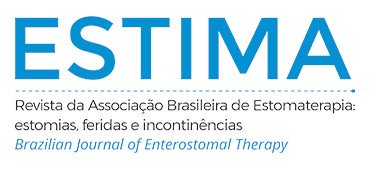APPLICATION OF THE DIAPER USE RATING SCALE IN A MEDICAL CLINIC OF A UNIVERSITY HOSPITAL
Abstract
Objetivos: aplicar a escala de avaliação do uso fraldas e absorventes (AUFA) nos pacientes internados na clínica médica; identificar e analisar os resultados dessa aplicação, o perfil sociodemográfico dos pacientes em vogo bem como repercussões à pele relacionadas ao uso de absorventes e fraldas. Método: estudo observacional transversal, descritivo e exploratório, realizado no setor de clínica médica do Hospital Universitário Clementino Fraga Filho (HUCFF/UFRJ), no período de novembro de 2019 a fevereiro de 2020, com amostra por conveniência de 46 pacientes. Ocorreu aplicação de ficha para levantamento de dados gerais e, após, a AUFA, que identificou as seguintes variáveis: condições da pele, envelhecimento da pele, capacidade cognitiva, capacidade motora e incontinências. Resultados: todos os 46 pacientes encontravam-se em uso de fralda, sendo metade mulheres e a outra metade homens, em grande maioria composta de idosos e sem diagnóstico de incontinência. Diante da aplicação e análise da AUFA, apenas 18 pacientes (39,14%) tinham indicação para uso de fraldas. Com o uso inadequado da fralda, 27 pacientes apresentaram lesão de pele decorrente de umidade, situação que se justificou pela ausência da observação de cuidados sistematizados para prevenção e tratamento de dermatite associada à incontinência nos pacientes avaliados. Conclusão: indica-se o uso da escala AUFA para identificar os pacientes que necessitam usar fralda, delimitando cuidados com seu manejo e prevenindo, assim, complicações e agravamentos da incontinência.
Downloads
Metrics
References
Bitencourt G R. Validação da escala de avaliação do uso de fraldas e absorventes em idosos na atenção primária [tese]. Rio de Janeiro (RJ): Escola de Enfermagem Aurora de Afonso Costa, Universidade Federal Fluminense; 2019.
Beeckman D, Van den Bussche K, Alves P, Beele H, Ciprandi G, Coyer F et al. The Ghent Global IAD Categorisation Tool (GLOBIAD). Skin Integrity Research Group - Ghent University. 2017. Disponível em: www.UCVVGent.be
Koudounas S, Bader DL, Voegeli D. Knowledge Gaps in the Etiology and Pathophysiology of Incontinence-Associated Dermatitis: A Scoping Review. J Wound Ostomy Continence Nurs. 2020; 47(4): 388-95. https://doi.org/10.1097/WON.0000000000000656
Fernández FPG, Casanova PL, Palma MR, Goméz TS, Agreda JJS. Guia: cuidados de la piel en pacientes con incontinência y prevención de lesiones asociadas de la humedad. Departamento de enfermeria comunitaria, medicina preventiva y salud pública e historia de la ciência; 2016. Disponível em: https://gneaupp.info/cuidados-de-la-piel-en-pacientes-con-incontinenciay-prevencion-de-lesiones-asociadas-a-la-humedad/
Cunha CV, Ferreira D, Nascimento D, Felix F, Cunha P, Penna LHG. Dermatite associada à incontinência em idosos: caracterização, prevenção e tratamento. ESTIMA, Braz J Enterestomal Ther. 2016; 13(3). Disponível em: https://www.revistaestima.com.br/estima/article/view/218
Bitencourt GR, Santana RF. Evaluation scale for the use of adult diapers and absorbent products: methodological study. Online Braz J Nurs. 2021; 20:e20216466. https://doi.org/10.17665/1676- 4285.20216466
Rodríguez-Palma M, Verdú-Soriano J, Soldevilla-Agreda JJ, Pancorbo-Hidalgo PL, García-Fernández FP. Conceptual Framework for Incontinence − Associated Dermatitis Based on Scoping Review and Expert Consensus Process. J Wound Ostomy Continence Nurs. 202;48(3): 239-50. https://doi.org/10.1097/WON.0000000000000754
Moraes JT, Borges EL, Lisboa CR, Cordeiro DCO, Rosa EG, Rocha NA. Conceito e classificação de lesão por pressão: atualização no National Pressure Ulcer Advisory Panel. Enferm Cent O Min. 2016;6(2): 2292-2306. https://doi.org/10.19175/recom.v6i2.1423
Alves LAF, Santana RF, Cardozo AS, Souza TM, Silva CFR. Dermatitis Associated with Incontinence and the Not-Standard Use of Geriatric Diaper: SystematicReview. ESTIMA Braz J Enterestomal Ther. 2016; 14(4):203-13. https://doi.org/10.5327/Z1806-3144201600040007
Zangirolami-Raimundo J, Echeimberg JO, Leone C. Tópicos de metodologia de pesquisa: Estudos de corte transversal. Journal of Human Growth and Development. 2018;28(3):356-60. https://doi.org/10.7322/jhgd.152198
Polit DF, Beck CT, Hungler BP. Fundamentos de pesquisa em enfermagem: avaliação de evidência para a prática da enfermagem. 7ª ed. São Paulo: Artmed; 2011.
Folstein MF, Folstein SE, McHugh PR. Mini-mental state: a practical method for grading the cognitive state of patients for the clinician. J Psychiatr Res. 1975;12(13):189-98. https://doi.org/10.1016/0022-3956(75)90026-6
Costa TNM, Nieto JPS, Morikawa LS, Araújo AVS, Cardoso AAM, Mafra BG et al. Analysis of Folstein’s Mini State examination in institutionalized and non institutionalized elderly people. Brazilian Journal of Health Review. 2021;4(2):8319-36. https://doi.org/10.34119/bjhrv4n2-357
Tamanini JTN, Dambros M, D’Ancona CAL, Palma PCR, Rodrigues Netto Junior N. Validation of the “International Consultation on Incontinence Questionnaire - Short Form” (ICIQ-SF) for Portuguese. Rev Saúde Pública. 2004;38(3):438-44. https://doi.org/10.1590/S0034-89102004000300015
Timmermans L, Falez F, Mélot C, Wespes E. Validation of use of the international consultation on incontinence questionnaireurinary incontinence-short form (ICIQ-UI-SF) for impairment rating: A transversal retrospective study of 120 patients. Neurourology and Urodynamics 2013;32(7):974-79. https://doi.org/10.1002/nau.22363
Yates A. Incontinence-associated dermatitis 1: riskfactors for skindamage. Nursing Times. 2020;116(3):46-50. Disponível em: https://www.nursingtimes.net/clinical-archive/tissue-viability/incontinence-associated-dermatitis-1-risk-factors-for-skindamage-02-03-2020/
Werth SL, Justice R. Prevalence of Moisture-Associated Skin Damage in an Acute Care Setting: Outcomes From a Quality Improvement Project. J Wound Ostomy Continence Nurs. 2019;46(1):51-4. https://doi.org/10.1097/WON.0000000000000499
Lopes EB, Pupulim JSL, Oliva APV. Perfil dos diagnósticos de enfermagem de pacientes internados em unidade de clínica médica. Cienc Cuid Saude. 2016;15(2):358-65. https://doi.org/10.4025/cienccuidsaude.v15i2.29356
Nobre IEAM, Barros LM, Gomes MLS, Silva LA, Lima ICS, Caetano JÁ. Sistema de classificação de pacientes de FUGULIN: perfil assistencial da clínica médica. Rev enferm UFPE online. 2017;11(4):1736-42. https://doi.org/10.5205/1981-8963-v11i4a15245p1736-1742-2017
Grden CRB, Martins AR, Cabral LPA, Reche PM, Arcaro G, Brasil D et al. Incontinence associated dermatitis in elderly people admitted to a university hospital. Rev Bras Enferm. 2020;73(Suppl 3) :e20190374. https://doi.org/10.1590/0034-7167-2019-0374
Malta DC, Bernal RTI, Lima MG, Araújo SSC, Silva MMA, Freitas MIF et al. Doenças crônicas não transmissíveis e a utilização de serviços de saúde: análise da Pesquisa Nacional de Saúde no Brasil. Rev Saude Publica. 2017; 51(Supl 1):4s. https://doi.org/10.1590/S1518-8787.2017051000090
Bitencourt GR, Alves LAF, Santana RF. Practice of use of diapers in hospitalized adults and elderly: cross-sectional study. Rev Bras Enferm. 2018;71(2):343-9. http://doi.org/10.1590/0034-7167-2016-0341
Downloads
Published
How to Cite
Issue
Section
License
Copyright (c) 2021 Felippe Sales Freitas Araújo, Karina Chamma Di Piero, Camila Castanho Cardinelli

This work is licensed under a Creative Commons Attribution 4.0 International License.

























